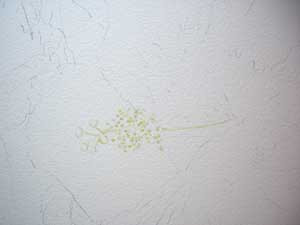 Even though the drawing is on the watercolor paper now, there is still another step before paint is applied to this piece. I wanted to mask the bright little areas near the center of this flower. If I mask these areas, they will be preserved and I don't have to be quite as careful when laying down the first few washes.
Even though the drawing is on the watercolor paper now, there is still another step before paint is applied to this piece. I wanted to mask the bright little areas near the center of this flower. If I mask these areas, they will be preserved and I don't have to be quite as careful when laying down the first few washes.To mask, I use a small container that holds a bar of soap and some water. You can use dish soap also, but I like the bar of soap because it is a little thicker. My second small container holds a tiny bit of masking, just enough for the current project. This protects my fragile masking fluid in its larger container. Masking dries out quickly, so I like to keep my larger container closed, except for pouring a small amount into my little container that I work from.
I use a small, cheap brush. Don't ever mix masking fluid or its water, with your watercolor paints or brushes. Any masking that gets into your water tub can eventually get into your good brushes and ruin them forever.
I saturate the brush with the soapy mixture by brushing into the very wet, thick bar of gooey soap. Then, I dip into the masking and apply a small amount at a time. Again, dip into the soapy mixture, pick up a little more masking and apply. The soap keeps your brush from getting saturated with masking fluid. The brush will stay soft and workable for a long time. The last thing I do is scrub the brush in the soapy mixture one last time. I don't wash out the brush, I just leave the soapy mixture in it. My masking brushes last a long time!
Allow the masking to air dry. If you dry it with a hair dryer, the heat can make the masking sink into the paper and it will be more difficult to remove.





No comments:
Post a Comment